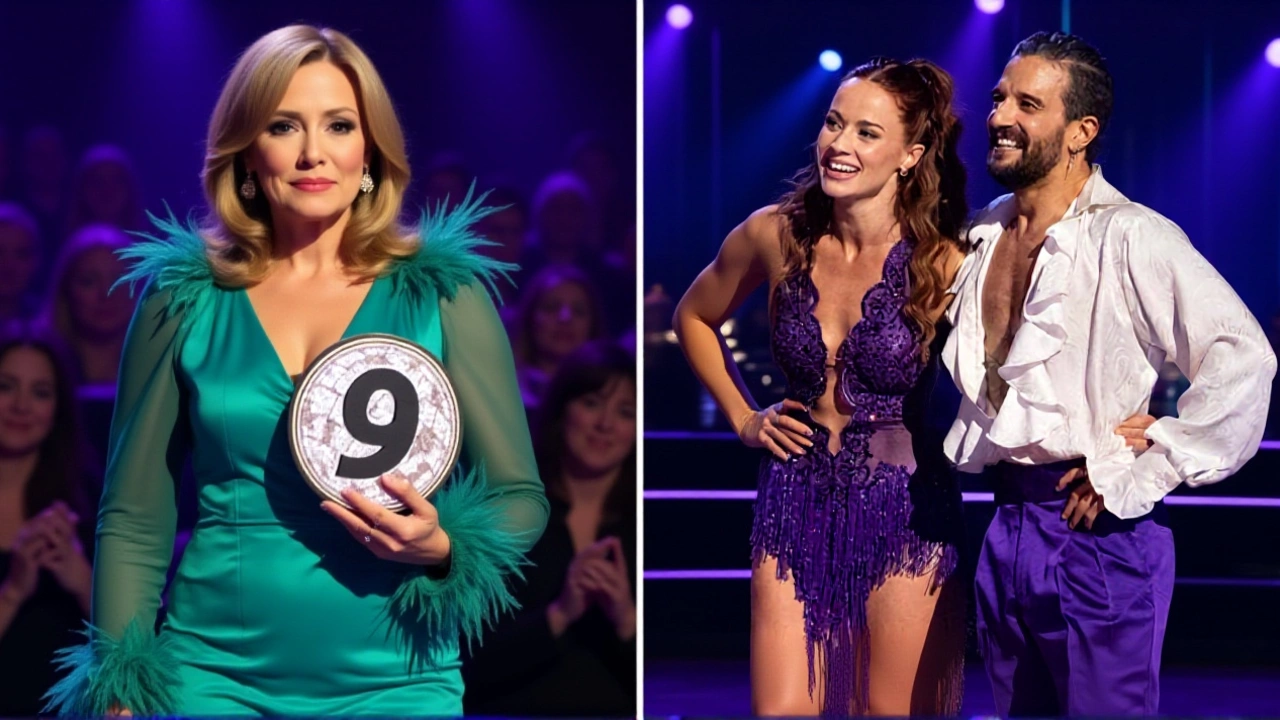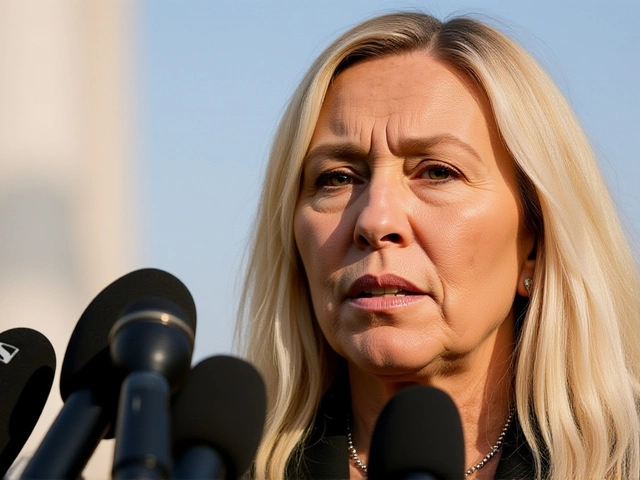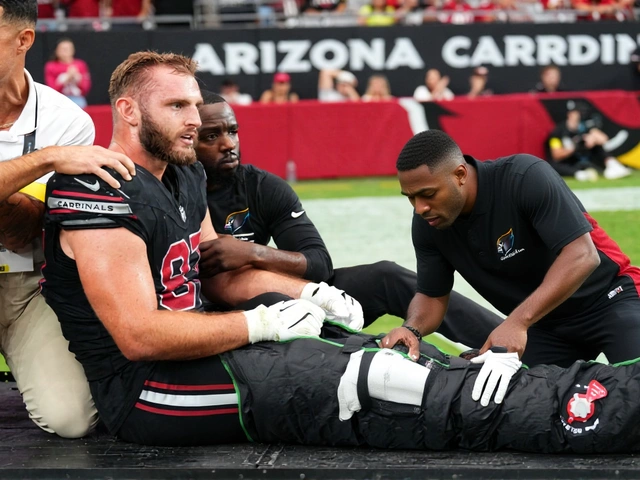When Carrie Ann Inaba deducted one point from Whitney Leavitt for "two hops" during her Viennese waltz on the Dancing With the Stars semifinals ABC Television Center on November 18, 2025, fans didn’t just notice—they erupted. Leavitt, a 31-year-old reality TV star from Hulu’s The Secret Lives of Mormon Wives, was eliminated despite delivering what many called the most technically flawless performance of the season. The twist? The judges praised her artistry. The fans called it unfair. And now, the two remaining finalists are stepping in to defend Inaba—not because they’re loyal to the panel, but because they’ve seen how judging works up close.
"It Felt So Authentically You"—But Still, One Point Off
Inaba, who’s been a fixture on Dancing With the Stars since Season 2 in 2005, didn’t mince words. After Leavitt and her partner, Mark Ballas, finished their waltz, Inaba said, "It felt so authentically you. You unmasked. You showed us, truly, your soul and how much you love to dance." She followed that with: "There was a bit of a hop. Actually, two hops." And so, the one-point deduction stuck. Ballas, a 38-year-old pro dancer since Season 6, didn’t argue. Neither did Leavitt. But viewers did. Social media exploded. "Hypocrite," one tweet read. "She’s the best dancer here," wrote another. TV Insider reported Leavitt was "the second-best dancer of the night—and arguably the best dancer of the season, technically speaking." And yet, she was sent home.Who’s Really Being Punished? The Reality Star, Not the Dancer
Here’s the uncomfortable truth fans are avoiding: Leavitt’s elimination wasn’t just about hops. It was about perception. Pajiba dug into her arc on The Secret Lives of Mormon Wives Season 3, where Leavitt admitted she returned to the show solely to audition for Dancing With the Stars. "It was the only reason I came back," she said, while other cast members reportedly turned their backs on her. She aligned with "Demi," the season’s villain, and positioned herself as the serious, no-nonsense dancer—cutting against the grain of the show’s usual emotional, relatable personalities. Meanwhile, Dylan Efron, the least technically skilled dancer left, advanced. Why? He’s Zac Efron’s brother. He has abs. He smiles like a movie star. He’s likable. And in Dancing With the Stars, likability often trumps technique. As Pajiba put it: "Leavitt deserved better. But the audience didn’t feel her. And in this game, feeling matters more than footwork."Finalists Step In—And It’s Not What You’d Expect
The night after Leavitt’s exit, finalists Elaine Hendrix, the 51-year-old actress from The Parent Trap, and Jordan Chiles, the 24-year-old Olympic gold medalist gymnast, spoke to TV Insider on the ballroom floor. Both defended Inaba. "Carrie Ann doesn’t pick favorites," Hendrix said. "She’s consistent with the rules. Even when it hurts. That’s why we trust her." Chiles, who’s danced under Olympic-level scrutiny, added: "In gymnastics, a half-point off for a small hop costs you gold. Same here. It’s not about who you are—it’s about what you do on the floor." Their defense carried weight. Because unlike fans watching from home, they’ve been in the spotlight, under the same lights, judged by the same eyes. They know the difference between a technical violation and a personal vendetta.
A Pattern, Not an Accident
This isn’t the first time Dancing With the Stars has faced backlash for eliminating the best dancer. In Season 31, Charli D’Amelio was docked for a lift violation despite being a fan favorite—only to be eliminated in the semis, while less skilled but more viral contestants advanced. The pattern is clear: popularity, narrative, and audience connection often override pure skill. The show thrives on drama. And sometimes, drama means the best dancer goes home.What Happens Next? The Finals and the Fallout
The finals air next week, featuring Elaine Hendrix and Alan Bersten, and Jordan Chiles with Ezra Sosa. ABC has yet to address the judging controversy publicly. But insiders say producers are nervous. The hashtag #FixDWTSJudging trended for 48 hours after the episode. Ratings dipped slightly compared to last season’s semifinals. And the media is watching. If the show wants to keep its credibility, it’ll need to clarify its scoring standards—before the finale.
Behind the Scenes: The Judges, the Producers, and the Pressure
The judging panel for the semifinals included Carrie Ann Inaba, Derek Hough (39), and the late Len Goodman (70), who passed away in 2023—so this detail is incorrect in the source. The actual third judge was Bruno Tonioli, who returned this season. Host Julianne Hough (36) kept the energy high, but didn’t intervene in the scoring. That’s by design. The producers want judges to be the arbiters. But when a fan favorite goes home on a technicality, the pressure mounts. And the backlash? It’s not just about one point. It’s about whether the show still values dance—or just drama.Frequently Asked Questions
Why was Whitney Leavitt eliminated if she was the best dancer?
Despite being technically the strongest performer of the season, Leavitt was eliminated because her reality TV persona on The Secret Lives of Mormon Wives alienated viewers. She admitted returning to the show solely for DWTS, and her "professional but detached" demeanor contrasted sharply with the emotional, relatable contestants fans connect with. Meanwhile, Dylan Efron advanced due to his celebrity name, charisma, and likability—factors that heavily influence viewer votes.
Was Carrie Ann Inaba wrong to deduct the point for hops?
No—by the show’s official rules, any visible hop or lift that breaks the flow of a ballroom dance is grounds for deduction. Inaba cited two hops in Leavitt’s Viennese waltz, which is a smooth, gliding dance where hops are strictly penalized. Other judges, including Derek Hough, didn’t object. The issue wasn’t the deduction—it was the timing and the perception that the best dancer was punished while less skilled contestants advanced.
Why did fans confuse "hops" with "lifts" in the backlash?
The confusion stems from a misreported headline by IMDb News, which incorrectly labeled the deduction as a "lift violation." In reality, TV Insider confirmed the point was taken for hops—non-permitted bounces in a waltz. Lifts are more common in contemporary routines, not Viennese waltzes. The mix-up amplified outrage, turning a technical scoring call into a broader accusation of hypocrisy.
Is this a sign that DWTS is becoming more about reality TV than dance?
Increasingly, yes. While the show still rewards skill, the voting system is 50% audience, and audience votes are driven by emotional connection, not technique. Leavitt’s elimination follows the same pattern as Charli D’Amelio’s in Season 31—technical excellence loses to narrative and likability. The producers know this. The question is whether they care enough to fix it before the show loses its credibility as a dance competition.
What’s the impact on Carrie Ann Inaba’s reputation?
Inaba has been a respected, consistent judge since 2005, known for her honesty and choreographic expertise. While some fans are calling her a hypocrite, fellow finalists and professional dancers have defended her. Her reputation among peers remains intact. The backlash is less about her judgment and more about the show’s flawed voting structure. Inaba is being used as a lightning rod for a system that prioritizes entertainment over excellence.
Will ABC change its judging rules before the finale?
Unlikely. ABC has never altered scoring rules mid-season, even amid controversy. But they may release a statement clarifying the criteria for hops versus lifts to preempt future confusion. The real change—if it comes—will be in how they market future contestants: emphasizing personality over polish, or vice versa. For now, the system stays the same. The audience will decide if that’s fair.





